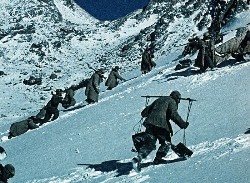Tibetet Segítő Társaság Sambhala Tibet Központ
Tibet Support Association Sambhala Tibet Center
székhely / telephely H-Budapest I. Attila út 123..
(00-36) 70 431 9343 (00-36)70 944 0260 (06-1)782 7721
sambhala@tibet.hu www.tibet.hu tibetpress.info
Facebook/Sambhala Tibet Központ Facebook/Tibett Segítő Társaság
MagnetBank/ 16200010-00110240
IBAN/HU94 16200010 00110240 00000000 SWIFT/HBWEHUHB
(1%) adószám/ 18061347-1-41
nyitva tartás/hétköznap 12.00-20.00 hétvégén előadás függő
» tibeti művészet» lapszemle.hu» thetibetpost.com» eastinfo.hu» rangzen.net» ChoegyalTenzin» tibet.net» phayul.com» DalaiLama.com» vilaghelyzete.blogspot.com» Videók» Linkek» TibetiHírek» Szerkesztőség
Banned 1954 documentary on Tibet resurfaces after more than sixty years/ENG
2019. február 20./Phayul.com/TibetPress
eredeti cikk
By Tenzin Sangmo
 DHARAMSHALA, Feb, 20: An original Czech documentary on Tibet from early 1950s resurfaced in Czech cinema world yesterday that saw a screening at Prague’s Lucerna cinema more than sixty years after its premiere, reported Radio Prague.
DHARAMSHALA, Feb, 20: An original Czech documentary on Tibet from early 1950s resurfaced in Czech cinema world yesterday that saw a screening at Prague’s Lucerna cinema more than sixty years after its premiere, reported Radio Prague.
Titled Cesta vede do Tibetu or The Road Leads to Tibet, shot by director Vladimír Sís and cameraman Josef Vaniš premiered in 1955 and won awards at the film festivals in Venice and Karlovy Vary. It was also screened in Czechoslovak cinemas in 1956 before it was banned by the Communist authorities.
Czechoslovakia remained under one-party communist rule for 41 years from the Communist coup d'état in February 1948 to the Velvet Revolution in 1989.
The filmmakers, the report said, were commissioned by the Czechoslovak Army film studios to cooperate with their Chinese colleagues on documenting the construction of the Sichuan-Tibet highway between China and Lhasa.
The new, digital copy, which was screened yesterday remains the only one of the film’s three official versions. “We cannot trace the Chinese version. The National Film Archive believes it has been destroyed and so was the version made for festivals,” said Viktor Kuna, the film distributor who rediscovered the documentary that had been lying forgotten in the National Film Archive for decades.
“Apart from the construction of the highway, they captured on film many cultural and religious monuments, as well as pictures of the everyday life of the Tibetan people, including their traditional costumes, the weaving of textiles and carpets, and traditional rituals and dances. “But what makes the film really unique is that it captures many places that have been destroyed during the Chinese Cultural Revolution,” added Kuna.
The filmmakers had captured their meeting with the 19-year-old Dalai Lama in the forbidden town of Lhasa before he left for exile, the report highlights.
At a time when Tibetans are set to commemorate the 60th anniversary of Tibetan National Uprising Day that took place on March 10, 1959, against the Chinese invasion, and in the ongoing atmosphere of severe repression in Tibet, the film serves as a unique testimony of places that have long been destroyed by the Chinese Cultural Revolution.
